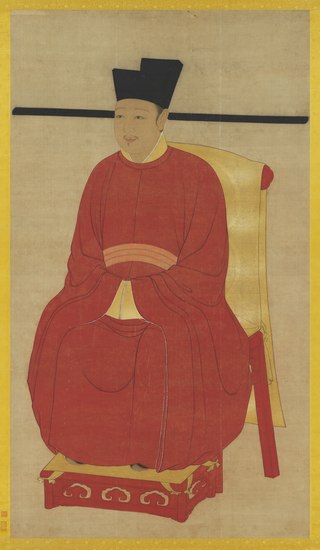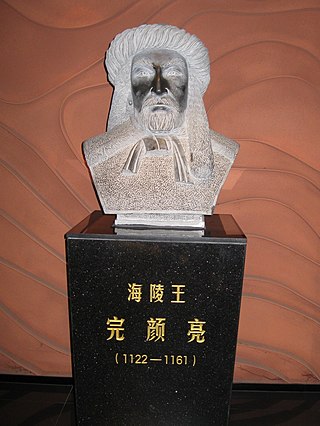Wuyashu (1061–1113) was a chieftain of the Wanyan tribe, the most dominant among the Jurchen tribes which later founded the Jin dynasty (1115–1234). He was the eldest son of Helibo and the elder brother of Aguda, the founder and first emperor of the Jin dynasty. He was posthumously honoured with the temple name Kangzong.

Emperor Huizong of Song, personal name Zhao Ji, was the eighth emperor of the Song dynasty of China and the penultimate emperor of the Northern Song dynasty. He was also a very well-known painter, poet and calligrapher. Born as the 11th son of Emperor Shenzong, he ascended the throne in 1100 upon the death of his elder brother and predecessor, Emperor Zhezong, because Emperor Zhezong's only son died prematurely. He lived in luxury, sophistication and art in the first half of his life. In 1126, when the Jurchen-led Jin dynasty invaded the Song dynasty during the Jin–Song Wars, Emperor Huizong abdicated and passed on his throne to his eldest son, Zhao Huan while Huizong assumed the honorary title of Taishang Huang. The following year, the Song capital, Bianjing, was conquered by Jin forces in an event historically known as the Jingkang Incident. Emperor Huizong and Emperor Qinzong and the rest of their family were taken captive by the Jurchens and brought back to the Jin capital, Huining Prefecture in 1128. The Emperor Taizong of Jin, gave the former Emperor Huizong a title, Duke Hunde, to humiliate him. After Zhao Gou, the only surviving son of Huizong to avoid capture by the Jin, declared himself as the dynasty's tenth emperor as Emperor Gaozong, the Jurchens used Huizong, Qinzong, and other imperial family members to put pressure on Gaozong and his court to surrender. Emperor Huizong died in Wuguocheng after spending about nine years in captivity. He, along with his successors, were blamed for the Song dynasty's decline.

Emperor Taizu of Jin, personal name Aguda, sinicised name Min, was the founder and first emperor of the Jurchen-led Jin dynasty of China. He was originally the chieftain of the Wanyan tribe, the most dominant among the Jurchen tribes which were subjects of the Khitan-led Liao dynasty. Starting in 1114, Aguda united the Jurchen tribes under his rule and rebelled against the Liao dynasty. A year later, he declared himself emperor and established the Jin dynasty. By the time of his death, the Jin dynasty had conquered most of the Liao dynasty's territories and emerged as a major power in northern China. In 1145, he was posthumously honoured with the temple name Taizu by his descendant Emperor Xizong.
Emperor Shizong of Jin, personal name Wulu, sinicised name Wanyan Yong, was the fifth emperor of the Jurchen-led Jin dynasty of China. Ruling from 1161 to 1189 under the era name "Dading", Emperor Shizong's reign was the longest and most stable among the Jin emperors.
Gushen, also known as Wushi or Hushe, and better known by his sinicised name Wanyan Xiyin, was a Jurchen noble and civil minister who lived in the founding and early years of the Jurchen-led Jin dynasty (1115–1234), which ruled northern China between the 12th and 13th centuries. He was a chief adviser to Aguda, the founder and first emperor of the Jin dynasty. Described by modern writers as the "Chief Shaman" of the pre-Jin Jurchen state, he became deeply interested in Han Chinese culture, and is particularly known as the creator of the first writing system for the Jurchen language.
Emperor Zhangzong of Jin, personal name Madage, sinicized name Wanyan Jing, was the sixth emperor of the Jurchen-led Jin dynasty of China. He reigned from 20 January 1189 to 29 December 1208.

Nara is a clan name shared by a number of royal Manchu clans, sometimes also transliterated as Nalan or Nalland. The four tribes of the Hūlun confederation (扈倫四部) – Hada, Ula, Hoifa and Yehe – were all ruled by clans bearing this name.

Emperor Taizong of Jin, personal name Wuqimai, sinicised name Wanyan Sheng, was the second emperor of the Jurchen-led Jin dynasty of China. His era name was "Tianhui" (天會). During his reign, the Jin dynasty conquered the Khitan-led Liao dynasty. He then led the Jin in their campaigns against the Song dynasty, captured the Northern Song capital in 1127 and went on to rule most of northern China. After his death, he was posthumously honoured with the temple name Taizong by his successor, Emperor Xizong.
Emperor Xizong of Jin, personal name Hela, sinicised name Wanyan Dan, was the third emperor of the Jurchen-led Jin dynasty of China. He reigned for about 15 years from 1135 to 1150. During his reign, the Jin dynasty launched several military campaigns against the Han-led Southern Song dynasty in southern China.

Digunai, also known by his sinicised name Wanyan Liang and his formal title Prince of Hailing, was the fourth emperor of the Jurchen-led Jin dynasty of China. He was the second son of Wanyan Zonggan, the eldest son of the dynastic founder Wanyan Aguda. He came to power in 1150 after overthrowing and murdering his predecessor, Emperor Xizong, in a coup d'état. During his reign, he moved the Jin capital from Shangjing to Yanjing, and introduced a policy of sinicisation. In 1161, after the Jin dynasty lost the Battle of Caishi against the Southern Song dynasty, Digunai's subordinates rebelled against him and assassinated him. After his death, even though he ruled as an emperor during his lifetime, he was posthumously demoted to the status of a prince – "Prince Yang of Hailing" (海陵煬王) – in 1162 by his successor, Emperor Shizong. However, in 1181, Emperor Shizong further posthumously demoted him to the status of a commoner, hence he is also known as the "Commoner of Hailing" (海陵庶人).
Hanpu, later Wanyan Hanpu, was a leader of the Jurchen Wanyan clan in the early tenth century. According to the ancestral story of the Wanyan clan, Hanpu came from Goryeo when he was sixty years old, reformed Jurchen customary law, and then married a sixty-year-old local woman who bore him three children. His descendants eventually united Jurchen tribes into a federation and established the Jin dynasty in 1115. Hanpu was retrospectively given the temple name Shizu (始祖) and the posthumous name Emperor Yixian Jingyuan (懿憲景元皇帝) by the Jin dynasty.
Helibo, alternatively rendered as Horimbo (1039–1092), was a chieftain of the Wanyan tribe, the most dominant among the Jurchen tribes which later founded the Jin dynasty (1115–1234). He was the second son of Wugunai. Like his grandfather, Shilu, Horimbo was appointed chieftain of the Wanyan tribe by the Khitan-led Liao dynasty, which ruled northern China between the 10th and 11th centuries.
Emperor Xuanzong of Jin, personal name Wudubu, sinicized names Wanyan Xun and Wanyan Congjia, was the eighth emperor of the Jurchen-led Jin dynasty of China. He was the second Jin emperor to be defeated by the Mongol Empire, and the first after they crossed the Great Wall in 1211 during the Jin campaign.

Jin Wuzhu, also known by his sinicised name Wanyan Zongbi (完顏宗弼), was a prince, military general and civil minister of the Jurchen-led Jin dynasty of China. He was the fourth son of Aguda, the founder and first emperor of the Jin dynasty. Wuzhu started his career in the military in his youth, when he participated in the Jurchen rebellion led by his father against the Khitan-led Liao dynasty. Between the late 1120s and 1130s, he fought for the Jin dynasty in a series of wars against the Han-led Northern Song dynasty and its successor state, the Southern Song dynasty. In 1137, in recognition of his contributions in battle, he was appointed as Right Vice-Marshal (右副元帥) and enfeoffed as the "Prince of Shen" (瀋王). In the final decade of his life, he was appointed to several high-ranking positions in the Jin imperial court, including Left Chancellor (左丞相), Palace Attendant (侍中), Taibao (太保), Marshal of the Capital (都元帥), Taifu (太傅), and Taishi (太師). He died of illness in 1148. Throughout his life, he had served under three Jin emperors – Emperor Taizu, Emperor Taizong, and Emperor Xizong.
Empress Mingde of the Wulinda clan, also known by her first posthumous name Empress Zhaode, was the wife of Emperor Shizong of Jin, the fifth emperor of the Jurchen-led Chinese Jin dynasty. Although she committed suicide before her husband became emperor, he proclaimed her empress upon his ascension and never gave the title to any other of his consorts.
Wanyan Zongjun (完顏宗峻), also known by his Jurchen name Shengguo (繩果), was an imperial prince of the Jurchen-led Jin dynasty. He was the second or third son of Emperor Taizu with his first empress, Empress Shengmu.
Wanyan Yungong, Jurchen name Hutuwa, was an imperial prince of China's Jurchen-led Jin dynasty. He was the son of the Emperor Shizong an Empress Mingde. He was the father of the Emperor Zhangzong and Emperor Xuanzong.





